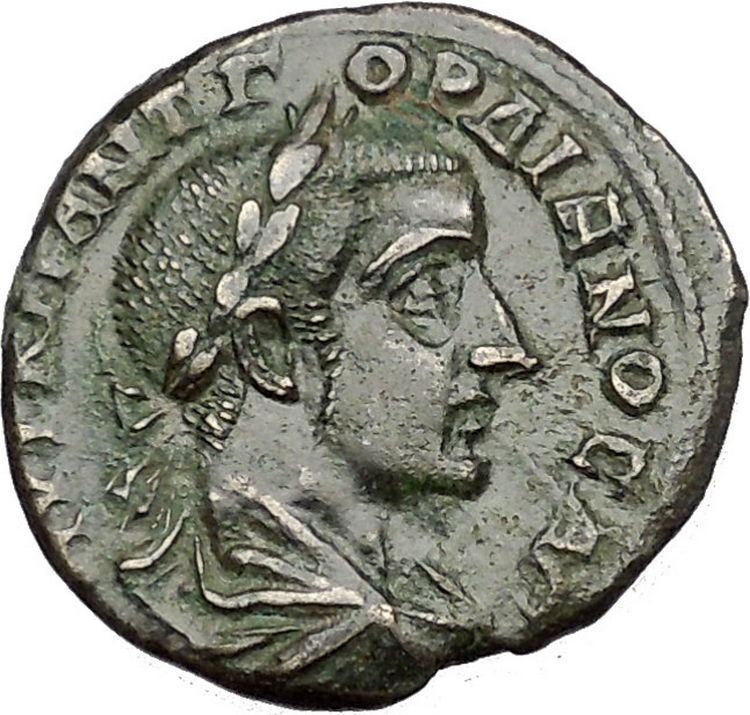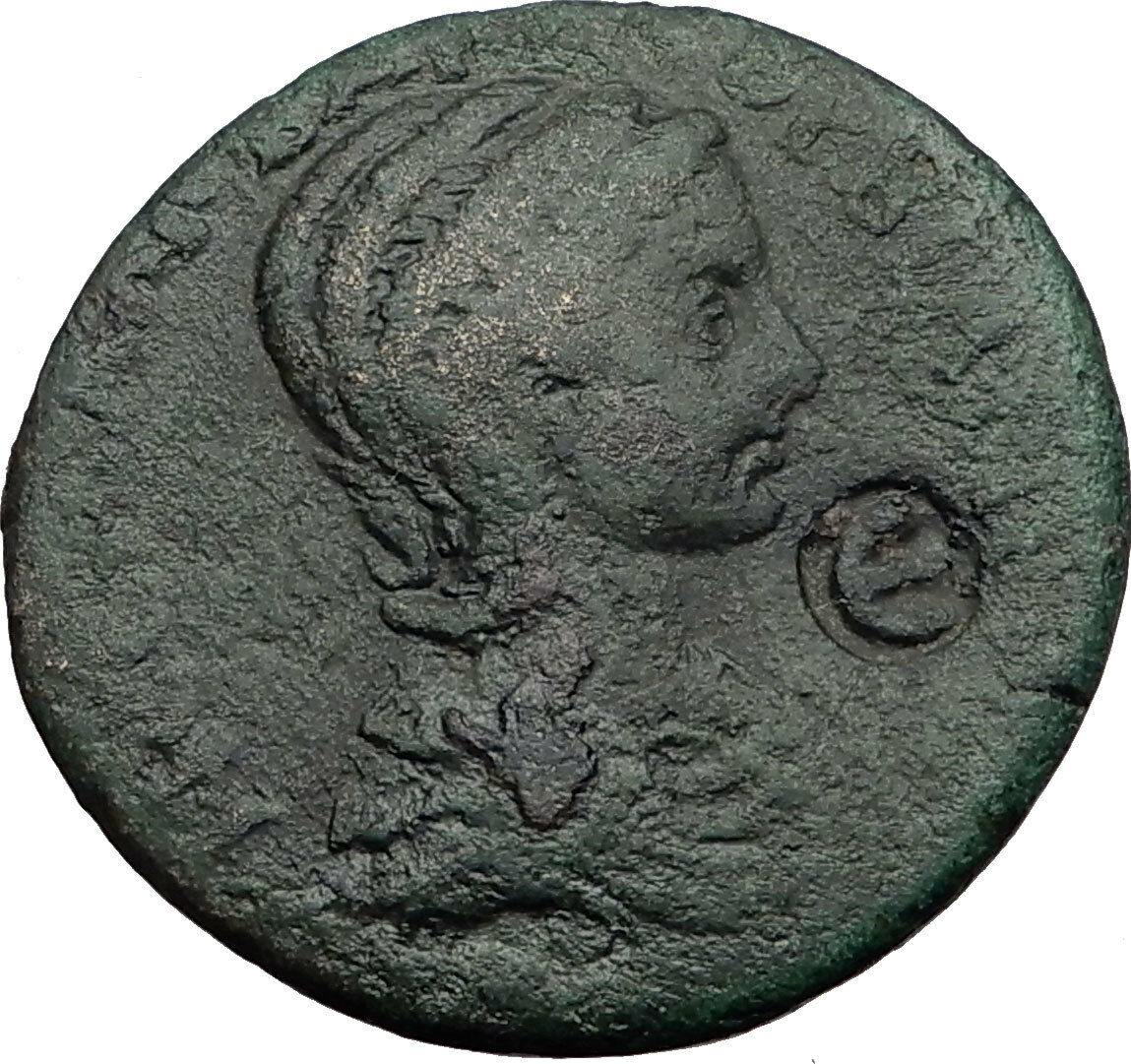|
Caracalla
–
Roman Emperor
: 198-217 A.D. –
Bronze 16mm (2.46 grams) of
Nicopolis ad Istrum
Laureate draped bust right
M AVP Λ ANTΩNIN, Bare-headed draped bust right.
NIKOΠΟΛIΤΩ ΠΡΟC ΙC, Nude
Dionysus
standing left, pouring out
kantharos and holding thyrsus.
You are bidding on the exact item pictured,
provided with a Certificate of Authenticity and Lifetime Guarantee of
Authenticity.
Dionysus or
Dionysos (Greek
Διόνυσος) is the
ancient Greek
god
of the grape harvest,
winemaking
and
wine
, of ritual madness and
ecstasy
, was also the driving force behind
Greek theater
. The god who inspires joyful
worship and
ecstasy
, festivals and celebration is a
major figure of
Greek mythology
and the
religion of ancient Greece
. He is included
as one of the
![2nd century Roman statue of Dionysus, after a Hellenistic model (ex-coll. Cardinal Richelieu, Louvre[1])](https://upload.wikimedia.org/wikipedia/commons/thumb/8/8a/Dionysos_Louvre_Ma87_n2.jpg/200px-Dionysos_Louvre_Ma87_n2.jpg)
twelve
Olympians in some lists. Dionysus is typical of the god of the
epiphany
, “the god that comes”. He was also
known as Bacchus, the name adopted by the
Romans
and the frenzy he induces,
bakkheia. Hailed as an Asiatic foreigner, he was thought to have had
strong ties to the East and to
Ethiopia
in the South. He was also known as
the Liberator (Eleutherios),
freeing one from one’s normal self, by madness, ecstasy or wine. The divine
mission of Dionysus was to mingle the music of the
aulos
and to bring an end to care and
worry. Scholars have discussed Dionysus’ relationship to the “cult of the
souls” and his ability to preside over communication between the living and
the dead.
In Greek mythology, Dionysus is made out to be a son of
Zeus
and the mortal
Semele
. He is described as being womanly or
“man-womanish”. The
retinue
of Dionysus was called the
thiasus
and was composed chiefly of
maenads
and
satyrs
. Dionysus is a god of
mystery religious rites
. In the
Thracian
mysteries, he wears the
bassaris or fox
-skin, symbolizing new life. His own
rites, the
Dionysian Mysteries
practiced by
maenads
and others, were the most secret of
all. Many scholars believe that Dionysus is a
syncretism
of a local Greek nature deity
and a more powerful god from
Thrace
or
Phrygia
such as
Sabazios
or
Zalmoxis
.
Contradictions in Dionysus’ origin suggest to some that we are dealing
not with the historical memory of a cult that is foreign, but with a god in
whom foreignness is inherent.
Karl Kerenyi
traces him to
Minoan Crete
, where his Minoan name is
unknown but his characteristic presence is recognizable. Clearly, Dionysus
had been with the Greeks and their predecessors a long time, and yet always
retained the feel of something alien.
In
Greek mythology
, a thyrsus or
thyrsos (Greek:
θύρσος
) was a staff of
giant fennel
(Ferula communis)
covered with ivy
vines and leaves, sometimes wound with
taeniae
and always topped with a
pine
cone
. These staffs were carried by
Dionysus
and his followers.
Euripides
wrote that
honey
dripped from the thyrsos staves that
the Bacchic
maenads
carried.The thyrsus was a sacred
instrument at religious rituals and
fêtes
.
Symbolism
The thyrsus, associated with
Dionysus
(or Bacchus) and his followers,
the
Satyrs
and
Maenads
, is a symbol of
prosperity
,
fertility
,
hedonism
, and pleasure/enjoyment in
general. It has been suggested that this was specifically a fertility
phallus
, with the fennel representing the
shaft of the penis and the pine cone representing the “seed” issuing forth.
The thyrsus was tossed in the Bacchic dance:
Pentheus: The thyrsus— in my right hand shall I hold it?
-
- Or thus am I more like a Bacchanal?
Dionysus: In thy right hand, and with thy right foot raise it”
Sometimes the thyrsus was displayed in conjunction with a
kantharos
wine cup, another symbol of
Dionysus, forming a male-and-female combination like that of the royal
scepter and orb.
Literature
In the Iliad
,
Diomedes
, one of the leading warriors of
the
Achaeans
, mentions the thyrsus while
speaking to
Glaucus
, one of the
Lycian
commanders in the
Trojan
army, about
Lycurgus
, the king of
Scyros
:
He it was that/drove the nursing women who were in charge/of frenzied
Bacchus through the land of Nysa,/and they flung their thyrsi on the
ground as/murderous Lycurgus beat them with his ox-/goad. (Iliad,
Book VI.132-37)
The thyrsus is explicitly attributed to Dionysus in
Euripides
‘s play
The Bacchae
as part of the costume of
the Dionysian cult.
…To raise my Bacchic shout, and clothe all who respond/ In fawnskin
habits, and put my thyrsus in their hands–/ The weapon wreathed with
ivy-shoots…” Euripides also writes, “There’s a brute wildness in the
fennel-wands—Reverence it well.” (The Bacchae and Other Plays,
trans. by Philip Vellacott, Penguin, 1954.)
Socrates
writes in
Phaedo
:
I conceive that the founders of the mysteries had a real meaning and
were not mere triflers when they intimated in a figure long ago that he
who passes unsanctified and uninitiated into the world below will live
in a slough, but that he who arrives there after initiation and
purification will dwell with the gods. For “many,” as they say in the
mysteries, “are the thyrsus bearers, but few are the mystics,”–meaning,
as I interpret the words, the true philosophers.
In Part II of
Johann Wolfgang von Goethe
‘s
Faust
,
Mephistopheles
tries to catch a
Lamia
, only to find out that she is an
illusion:
Well, then, a tall one I will catch…/And now a thyrsus-pole I
snatch!/Only a pine-cone as its head. (7775-7777)
Sookie Stackhouse notes the thyrsus carried by the maenad in the 2nd book
of
The Southern Vampire Mysteries
.
She idly waved the long wand with the tuft on the end. It was called
a thyrsis [sic];
I’d looked maenad up in the encyclopedia. Now I could die educated.
(Harris, Charlaine (2006-09-01). “Living Dead in Dallas: A Sookie
Stackhouse Novel”}
Gallery
-
A Bacchant holding a thyrsus: Malice, by
William-Adolphe Bouguereau
,
1899
-
Roman relief showing a Maenad holding a thyrsus (Prado,
Madrid
).
-
Bacchus Triumphant (1882)
by
John Reinhard Weguelin
-
A Maenad uses her thrysos to ward off a Satyr,
Attic red-figure
kylix
, circa 480 BC
Nicopolis ad Istrum was a
Roman
and Early
Byzantine
town founded by Emperor
Trajan
around 101–106, at the junction of
the Iatrus (Yantra)
and the Rositsa
rivers, in memory of his victory
over the Dacians
. Its ruins are located at the
village of
Nikyup
, 20 km north of
Veliko Tarnovo
in northern
Bulgaria
. The town reached its apogee
during the reigns of Trajan,
Hadrian
, the
Antonines
and the
Severan dynasty
.
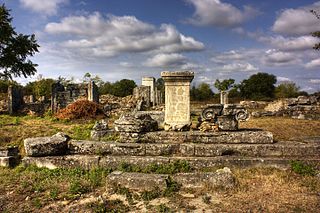
The classical town was planned according to the orthogonal system. The
network of streets, the forum surrounded by an Ionic colonnade and many
buildings, a two-nave room later turned into a basilica and other public
buildings have been uncovered. The rich architectures and sculptures show a
similarity with those of the ancient towns in Asia Minor. Nicopolis ad
Istrum had issued coins, bearing images of its own public buildings.
In
447 AD
, the town was destroyed by
Attila’s
Huns
. Perhaps it was already abandoned
before the early 400s. In the 6th century, it was rebuilt as a powerful
fortress enclosing little more than military buildings and churches,
following a very common trend for the cities of that century in the Danube
area.The largest area of the extensive ruins (21.55 hectares) of the
classical Nicopolis was not reoccupied since the fort covered only one
fourth of it (5.75 hectares), in the southeastern corner. The town became an
episcopal centre during the early Byzantine period. It was finally destroyed
by the Avar invasions at the end of the 6th century. A Bulgarian medieval
settlement arose upon its ruins later (10th-14th century).
Nicopolis ad Istrum can be said to have been the birthplace of
Germanic
literary tradition. In the 4th
century, the Gothic
bishop, missionary and translator
Ulfilas
(Wulfila) obtained permission from
Emperor
Constantius II
to immigrate with his flock
of converts to Moesia and settle near Nicopolis ad Istrum in 347-8. There,
he invented the
Gothic alphabet
and translated the
Bible
from
Greek
to
Gothic
.
Caracalla (Latin:
Marcus Aurelius Severus Antoninus Augustus;4
April 188 – 8 April 217) was
Roman emperor
from 198 to 217 The eldest
son of
Septimius Severus
, for a short time he
ruled jointly with his younger brother
Geta
until he had him murdered in 211.
Caracalla is remembered as one of the most notorious and unpleasant of
emperors because of the massacres and persecutions he authorized and
instigated throughout the Empire.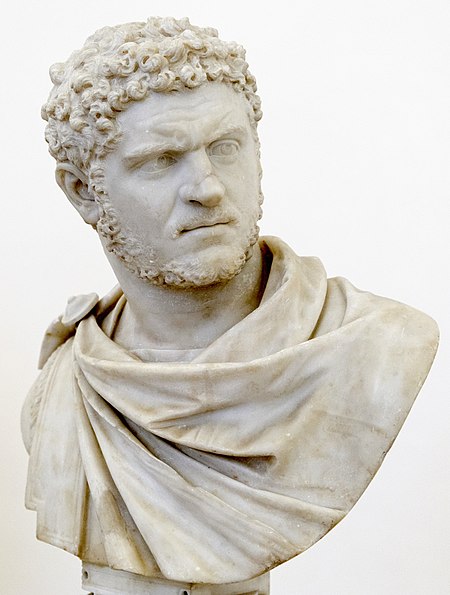
Caracalla’s reign was also notable for the
Constitutio Antoniniana
(also called
the Edict of Caracalla), granting
Roman citizenship
to all freemen throughout
the Roman Empire
, which according to historian
Cassius Dio
, was done for the purposes of
raising tax revenue. He is also one of the emperors who commissioned a large
public bath-house (thermae)
in Rome. The remains of the
Baths of Caracalla
are still one of the
major tourist attractions of the Italian capital.
Early life
Caracalla, of mixed
Punic
–Roman
and Syrian
descent, was born Lucius Septimius
Bassianus in
Lugdunum
,
Gaul
(now
Lyon
,
France
), the son of the later Emperor
Septimius Severus and
Julia Domna
. At the age of seven, his name
was changed to Marcus Aurelius Septimius Bassianus Antoninus to create a
connection to the family of the philosopher emperor
Marcus Aurelius
. He was later given the
Caracallanickname
,
which referred to the Gallic hooded tunic he habitually wore and which he
made fashionable.
Reign (211)
Murder of
brother (211)
His father died in 211 at
Eboracum
(now
York
) while on campaign in northern
Britain. Caracalla was present and was then proclaimed emperor by the troops
along with his brother
Publius Septimius Antoninus Geta
. Caracalla
suspended the
campaign in Caledonia
and soon ended all
military activity, as both brothers wanted to be sole ruler thus making
relations between them increasingly hostile. When they tried to rule the
Empire jointly they actually considered dividing it in halves, but were
persuaded not to do so by their mother.
Then in December 211 at a reconciliation meeting arranged by their mother
Julia, Caracalla had Geta assassinated by members of the Praetorian Guard
loyal to himself, Geta dying in his mother’s arms. Caracalla then persecuted
and executed most of Geta’s supporters and ordered a
damnatio memoriae
pronounced by the
Senate against his brother’s memory.
Geta’s image was simply removed from all coinage, paintings and statues,
leaving a blank space next to Caracalla’s. Among those executed were his
former cousin-wife
Fulvia Plautilla
, his unnamed daughter with
Plautilla along with her brother and other members of the family of his
former father-in-law
Gaius Fulvius Plautianus
. Plautianus had
already been executed for alleged treachery against emperor Severus in 205.
About the time of his accession he ordered the
Roman currency
devalued, the silver purity
of the denarius
was decreased from 56.5% to 51.5%,
the actual silver weight dropping from 1.81 grams to 1.66 grams – though the
overall weight slightly increased. In 215 he introduced the
antoninianus
, a “double denarius”
weighing 5.1 grams and containing 2.6 grams of silver – a purity of 52%.
In the Roman
provinces
In 213, Caracalla went north to the German frontier to deal with the
Alamanni
tribesmen who were raiding in the
Agri Decumates
. The Romans did defeat the
Alamanni in battle near the river
Main
, but failed to win a decisive victory
over them. After a peace agreement was brokered and a large bribe payment
given to the invaders, the Senate conferred upon him the empty title of
Germanicus Maximus. He also acquired the surname Alemannicus at
this time. The following year the tyrant traveled to the East, to Syria and
Egypt never to return to Rome.
Gibbon
in his work describes Caracalla as
“the common enemy of mankind”. He left the capital in 213, about a year
after the murder of Geta, and spent the rest of his reign in the provinces,
particularly those of the East. He kept the Senate and other wealthy
families in check by forcing them to construct, at their own expense,
palaces, theaters, and places of entertainment throughout the periphery. New
and heavy taxes were levied against the bulk of the population, with
additional fees and confiscations targeted at the wealthiest families.
When the inhabitants of
Alexandria
heard Caracalla’s claims that he
had killed Geta in self-defense, they produced a satire mocking this as well
as Caracalla’s other pretensions. In 215, Caracalla savagely responded to
this insult by slaughtering the deputation of leading citizens who had
unsuspectingly assembled before the city to greet his arrival, and then
unleashed his troops for several days of looting and plunder in Alexandria.
According to historian Cassius Dio, over 20,000 people were killed.[citation
needed]
Domestic Roman
policy
Affiliation
with the army
During his reign as emperor, Caracalla raised the annual pay of an
average legionary to 675
denarii
and lavished many benefits on
the army which he both feared and admired, as instructed by his father
Septimius Severus who had told him on his deathbed to always mind the
soldiers and ignore everyone else. Caracalla did manage to win the trust of
the military with generous pay rises and popular gestures, like marching on
foot among the ordinary soldiers, eating the same food, and even grinding
his own flour with them.
With the soldiers, “He forgot even the proper dignity of his rank,
encouraging their insolent familiarity,” according to Gibbon. “The vigour of
the army, instead of being confirmed by the severe discipline of the camps,
melted away in the luxury of the cities.”

|
O:
laureate
head of Caracalla
ANTONINVS
PIVS
AVG
GERM
|
R:
Sol
holding
globe
, rising hand
P M
TR P
_XVIIII
COS
IIII
P P
|
|
silver
denarius
struck in
Rome
216; ref.: RIC 281b, C 359 |
His official portraiture marks a break with the detached images of the
philosopher–emperors who preceded him: his close-cropped haircut is that of
a soldier, his pugnacious scowl a realistic and threatening presence. This
rugged soldier–emperor iconic archetype was adopted by most of the following
emperors who depended on the support of the troops to rule, like his
eventual successor
Maximinus Thrax
.
Seeking to secure his own legacy, Caracalla also commissioned one of
Rome’s last major architectural achievements, the
Baths of Caracalla
, the 2nd largest public
baths ever built in ancient Rome. The main room of the baths was larger than
St. Peter’s Basilica
, and could easily
accommodate over 2,000 Roman citizens at one time. The bath house opened in
216, complete with libraries, private rooms and outdoor tracks. Internally
it was lavishly decorated with gold-trimmed marble floors, columns, mosaics
and colossal statuary.
Edict of
Caracalla (212)
The
Constitutio Antoniniana
(Latin:
“Constitution [or Edict] of Antoninus”) (also called Edict of Caracalla)
was an edict issued in 212 by Caracalla which declared that all free men in
the Roman Empire were to be given full Roman citizenship and all free women
in the Empire were given the same rights as Roman women.
Before 212, for the most part only inhabitants of Italia held full Roman
citizenship. Colonies of Romans established in other provinces, Romans (or
their descendants) living in provinces, the inhabitants of various cities
throughout the Empire, and small numbers of local nobles (such as kings of
client countries) held full citizenship also. Provincials, on the other
hand, were usually non-citizens, although many held the
Latin Right
.
The Roman Historian
Cassius Dio
contended that the sole
motivation for the edict was a desire to increase state revenue.At the time
aliens did not have to pay most taxes that were required of citizens, so
although nominally Caracalla was elevating their legal status, he was more
importantly expanding the Roman tax base. The effect of this was to remove
the distinction that citizenship had held since the foundation of Rome and
as such the act had a profound effect upon the fabric of Roman society.[16]
War with Parthia
According to the historian Herodian, in 216, Caracalla tricked the
Parthians into believing that he accepted a marriage and peace proposal, but
then had the bride and guests slaughtered after the wedding celebrations.
The thereafter ongoing conflict and skirmishes became known as the
Parthian war of Caracalla
.
Assassination
(217)
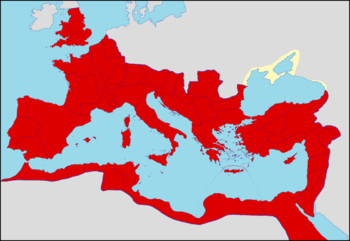
The Roman Empire during the reign of Caracalla.
While travelling from
Edessa
to continue the war with
Parthia
, he was assassinated while
urinating at a roadside near
Carrhae
on 8 April 217 (4 days after his
29th birthday), by Julius Martialis, an officer of his personal bodyguard.
Herodian
says that Martialis’ brother had
been executed a few days earlier by Caracalla on an unproven charge; Cassius
Dio, on the other hand, says that Martialis was resentful at not being
promoted to the rank of centurion. The escort of the emperor gave him
privacy to relieve himself, and Martialis then ran forward and killed
Caracalla with a single sword stroke. While attempting to flee, the bold
assassin was then quickly dispatched by a Scythian archer of the Imperial
Guard.
Caracalla was succeeded by his
Praetorian Guard Prefect
,
Macrinus
, who (according to Herodian) was
most probably responsible for having the emperor assassinated.
His nickname
According to
Aurelius Victor
in his Epitome de
Caesaribus, the
agnomen
“Caracalla” refers to a Gallic
cloak
that Caracalla adopted as a personal
fashion, which spread to his army and his court. Cassius Dio and the
Historia Augusta
agree that his
nickname was derived from his cloak, but do not mention its country of
origin.
Legendary king
of Britain
Geoffrey of Monmouth
‘s legendary
History of the Kings of Britain
makes
Caracalla a king of Britain, referring to him by his actual name “Bassianus”,
rather than the nickname Caracalla. In the story, after Severus’s death the
Romans wanted to make Geta king of Britain, but the Britons preferred
Bassianus because he had a British mother. The two brothers fought a battle
in which Geta was killed and Bassianus succeeded to the throne. He ruled
until he was betrayed by his
Pictish
allies and overthrown by
Carausius
, who, according to Geoffrey, was
a Briton, rather than the historically much later
Menapian
Gaul that he actually was.
|




![2nd century Roman statue of Dionysus, after a Hellenistic model (ex-coll. Cardinal Richelieu, Louvre[1])](https://upload.wikimedia.org/wikipedia/commons/thumb/8/8a/Dionysos_Louvre_Ma87_n2.jpg/200px-Dionysos_Louvre_Ma87_n2.jpg)

_-_Mailice_(1899).jpg/83px-William-Adolphe_Bouguereau_(1825-1905)_-_Mailice_(1899).jpg)
_04b.jpg/116px-Ménade_relieve_romano_(Museo_del_Prado)_04b.jpg)
.jpg/76px-John_Reinhard_Weguelin_–_Bacchus_Triumphant_(1882).jpg)






